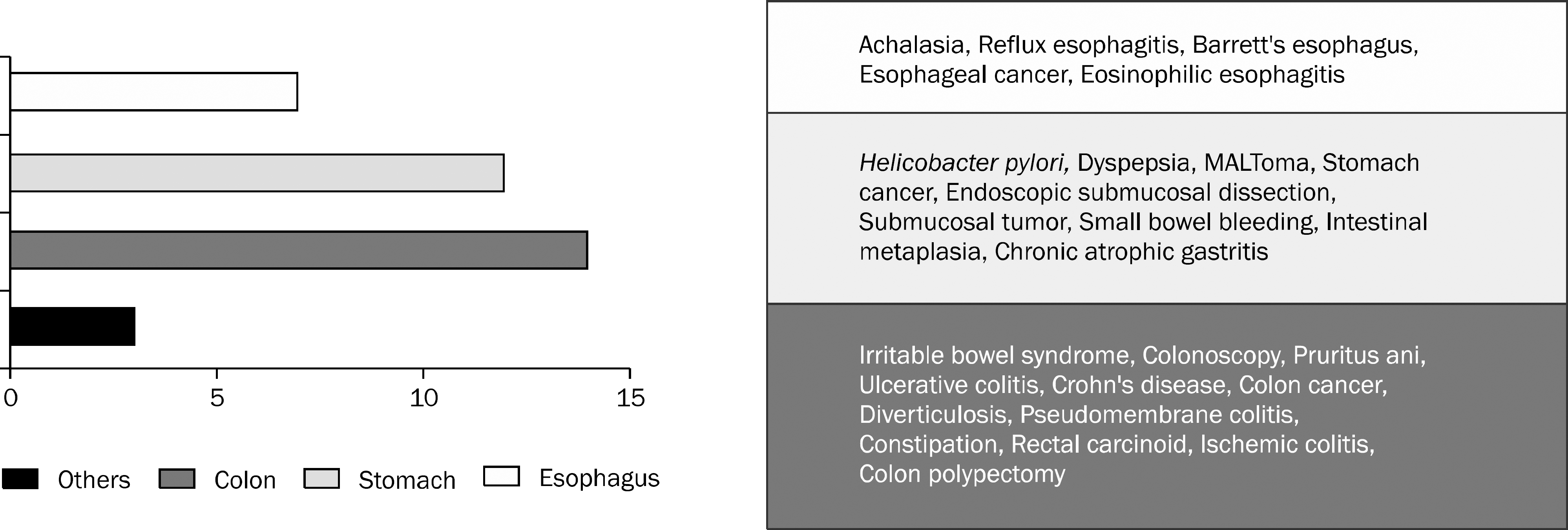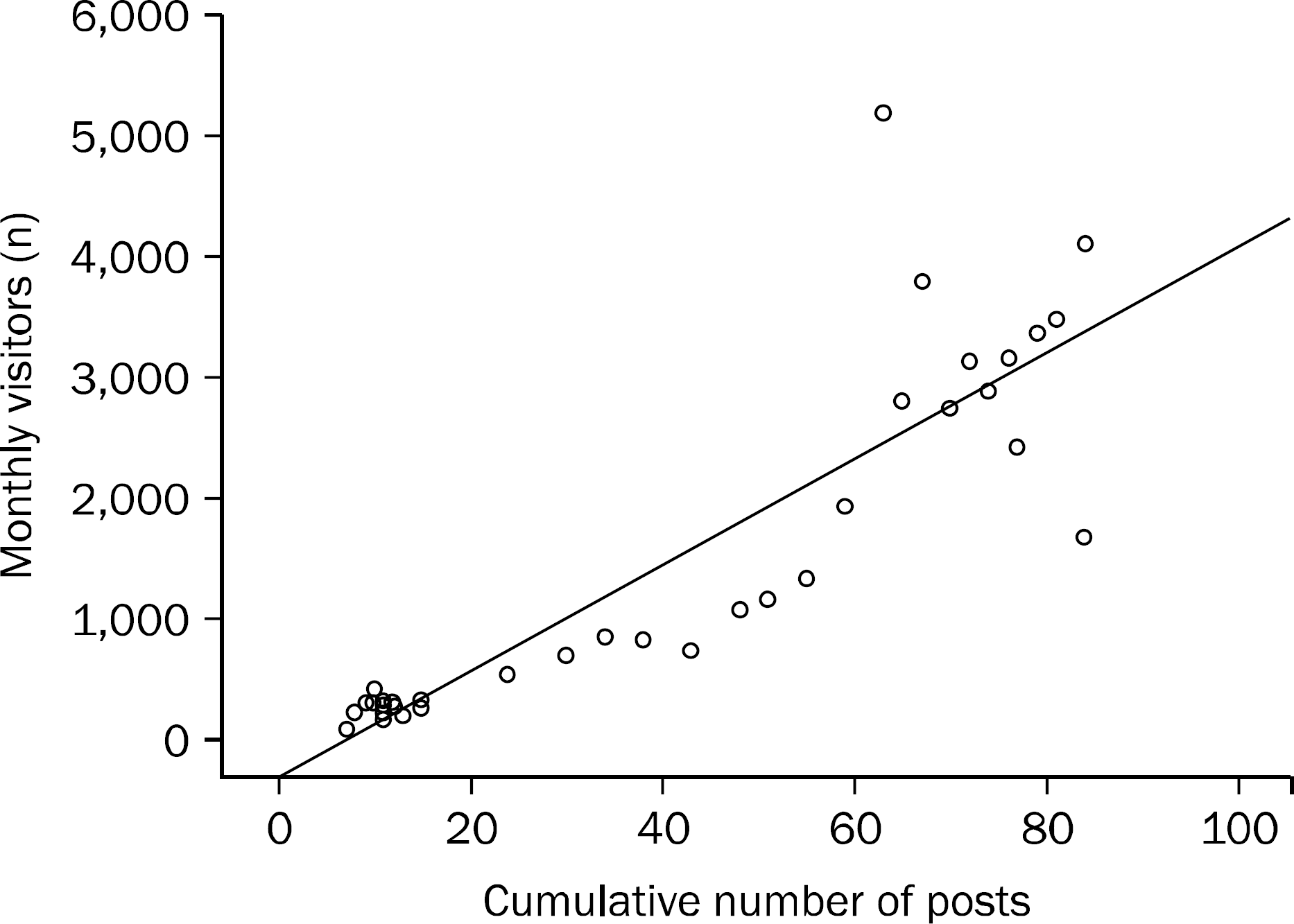Abstract
Background/Aims
With the enormous increase in the amount of data, the concept of big data has emerged and this allows us to gain new insights and appreciate its value. However, analysis related to gastrointestinal diseases in the viewpoint of the big data has not been performed yet in Korea. This study analyzed the data of the blog's visitors as a set of big data to investigate questions they did not mention in the clinical situation.
Methods
We analyzed the blog of a professor whose subspecialty is gastroenterology at Gangnam Severance Hospital. We assessed the changes in the number of visitors, access path of visitors, and the queries from January 2011 to December 2013.
Results
A total of 50,084 visitors gained accessed to the blog. An average of 1,535.3 people visited the blog per month and 49.5 people per day. The number of visitors and the cumulative number of registered posts showed a positive correlation. The most utilized access path of visitors to the website was blog.iseverance.com (42.2%), followed by Google (32.8%) and Daum (6.6%). The most searched term by the visitors in the blog was intestinal metaplasia (16.6%), followed by dizziness (8.3%) and gastric submucosal tumor (7.0%).
Conclusions
Personal blog can function as a communication route for patients with digestive diseases. The most frequently searched word necessitating explanation and education was ‘intestinal metaplasia'. Identifying and analyzing even unstructured data as a set of big data is expected to provide meaningful information.
References
1. What is big data? Bringing big data to the enterprise. [Internet]. Armonk (NY): IBM [cited 2014 Jan 10]. Available from:. http://www-01.ibm.com/software/data/bigdata/what-is-big-data.html.
2. Guideline for analysis of big data. [Internet]. Seoul: National Information Society Agency;2013 Jan 25. [cited 2014 Jan 10]. Available from:. http://www.nia.or.kr/bbs/board_view.asp?BoardID=201111281321074458&id=10343&Order=010200&search_target=&keyword=&Flag=010000&nowpage=2&objpage=0.
3. Ginsberg J, Mohebbi MH, Patel RS, Brammer L, Smolinski MS, Brilliant L. Detecting influenza epidemics using search engine query data. Nature. 2009; 457:1012–1014.

4. Microsoft expands presence in healthcare IT industry with acquisition of health intelligence software Azyxxi. [Internet]. Redmond (WA): Microsoft Press;2006 Jul 26. [cited 2014 Jan 10]. Available from:. http://www.microsoft.com/en-us/news/press/2006/jul06/07-26azyxxiacquisitionpr.aspx.
5. Won HH, Myung W, Song GY, et al. Predicting national suicide numbers with social media data. PLoS One. 2013; 8:e61809.

6. An analysis of data for a better future-big data case study in the developed nation. [Internet]. Seoul: National Information Society Agency;2013 Apr 16. [cited 2014 Jan 10]. Available from:. http://www.nia.or.kr/bbs/board_view.asp?BoardID=201111281321074458&id=10764&Order=010200&search_target=&keyword=&Flag=010000&nowpage=2&objpage=0.
7. Weblogs: a history and perspective. [Internet]. San Francisco (CA): Rebecca's Pocket;2000 Sep 7. [cited 2014 Jan 10]. Available from:. http://www.rebeccablood.net/essays/weblog_history.html.
8. Mutum D, Wang Q. Consumer generated advertising in blogs. Eastin MS, Daugherty T, Neal M, editors. Handbook of research on digital media and advertising: user generated content consumption. Hershey: Information Science Reference;2010.

9. Gaudeul A, Peroni C. Reciprocal attention and norm of reci-procity in blogging networks. Jena economic research papers. 2010–020. Jena: Jena University;2010.
10. Ranking in sites of general hospital. [Internet]. Seoul: MediaChannel [cited 2014 Jan 10]. Available from:. http://www.rankey.com/rank/rank_site_cate.php?cat1_id=1&cat2_id=24&cat3_id=253.
11. Harsha AK, Schmitt JE, Stavropoulos SW. Know your market: use of online query tools to quantify trends in patient information- seeking behavior for varicose vein treatment. J Vasc Interv Radiol. 2014; 25:53–57.
12. Big data analytics. [Internet]. Renton (WA): TDWI;2011 Sep 14. [cited 2014 Jan 10]. Available from:. http://tdwi.org/research/2011/12/sas_best-practices-report-q4-big-data-analytics.aspx?tc=page0.
13. In next year the big data bubble will fall. [Internet]. Seoul: DigitalTimes;2013 Oct 20. [cited 2014 Jan 10]. Available from:. http://www.dt.co.kr/contents.html?article_no=2013102102010860718002.
Fig. 1.
Understanding of digestive disease. There are various posts about digestive disease in blog.

Fig. 2.
The correlation between accumulation of posts and the number of monthly visitors. Two variables show a positive correlation, R=0.878 (p<0.01).

Table 1.
Blog Statistics (Based on September 2013)
| Blog name | Visitor (n) | Post (n) |
|---|---|---|
| Blog 1 a | 41,935 | 79 |
| Blog 2 | 4,118 | 3 |
| Blog 3 | 3,578 | 4 |
| Blog 4 | 22,804 | 42 |
| Blog 5 | 20,385 | 12 |
| Blog 6 | 27,291 | 23 |
| Blog 7 | 12,288 | 54 |
| Blog 8 | 5,870 | 6 |
| Blog 9 | 13,509 | 14 |
| Blog 10 | 13,039 | 28 |
| Blog 11 | 6,215 | 3 |
| Blog 12 | 12,905 | 46 |
| Blog 13 | 860 | 1 |
Table 2.
Blog Contents
Table 3.
Ranking on the Access Path of Visitors
| Site | Access path (n) |
|---|---|
| 1. blog.iseverance.com | 10,772 (42.2) |
| 2. www.google.co.kr | 8,356 (32.8) |
| 3. search.daum.net | 1,681 (6.6) |
| 4. search.naver.com | 1,098 (4.3) |
| 5. www.internetsupervision.com | 776 (3.0) |
| 6. m.search.naver.com | 521 (2.0) |
| 7. gs.iseverance.com | 487 (1.9) |
| 8. www.facebook.com | 360 (1.4) |
| 9. image.postman.co.kr | 251 (1.0) |
| 10. www.iseverance.com | 191 (0.7) |
Table 4.
Ranking on Searching Words in the Blog




 PDF
PDF ePub
ePub Citation
Citation Print
Print


 XML Download
XML Download